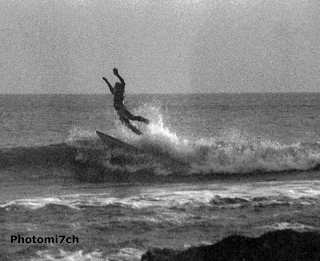It
is a fact of life for film users, if it was not for the those
tiny light sensitive particles we would not have some of the world
greatest pictures. All the same overly grainy negatives are a pain if
you have not planned for it to happen it's a big let down. You must
not forget that it is not all about the journey it is about the
results as well and what looks like rubbish to you now. Maybe an
inspired choice to others.
The
fact you have a negative to look at is a result and something that
will print and or scan. At one time grainy pictures were all the
rage. Producing some wonderfully expressive images. Admittedly they
are not everyone's cup of tea. In other words keep an open mind.
The
object of developer is
to bring out the latent image held in the emulsion. This is achieved
by a chemical reaction, acting on the silver, producing dark areas
where it is light and bright areas where there is shadow. The
negative is reversed later with the print. There are three important
things to keep at the front of your mind are: the development time,
the temperature and dilution. It is these three factors that ensure
the ultimate image quality when it comes to printing. Too short a
development time will produce too thin a negative, like wise too long
a process time will make the negative too dense, leading to very
short and very long print times respectively.
Agitation
is important as well and one of the most over looked parts of the
film development,
it can in some cases make the difference in how well your negatives
turn out. As the developer interacts with the emulsion of the film,
it vigorously attacks the silver it comes into contact with and
becomes exhausted. By inverting the tank you refresh this action,
producing evenly developed negatives. It is important
to get this right. To little agitation will allow by-products of the
process to build up, leaving pale-toned streamers as they slide to
the bottom of the film. Likewise excessive inversions will produce
currents in the developer, creating uneven development. Most process
times allow for agitation.
Developers:
The
first thing to look at is the developer. This has the most influence
over how your negatives will look. Before you settle on one in
particular make sure you understand its attributes. On a practical
note you also need to know how often you will process a film. If you
are going to process a film every week or so then it may be better to
use one in powder form like ID11 or D76. Or a one shot liquid for
occasional use, like Ilfotec HC or Kodak HC110. I have suggested
these developers because they are main stream fine grain developers.
RO9 is not recognized as a fine grain.
For
example:
Ilford
ID11: A full speed developer
with fine grain.
Supplied as a two pack powder. Down side is that you have to make up
5 liters of stock solution. This then leads to question over it's
keeping qualities. ( I have taken a year to use a 5ltr batch without
any loss of quality) It can be used as one shot or multi use with
allowance for depletion. ( I have only ever used as a one shot.)
Ilfords
Ilfotec HC: A highly
concentrated, fine grain liquid developer. It is suggested that this
is the liquid equivalent to ID11.
Kodak
D76: Fine grain developer recognized as Kodak's ID11. It has been reformulated as a one pack
powder. The down side is that it needs very hot water to mix it
easily.
Kodak
HC 110: A fine grain sharp
working developer. In a highly concentrated liquid syrup form. This
is Kodak's answer to ID11/D76 as a liquid.
One
more developer to what could be a very long list and that is:
RO9
Special/ Studional. These are
the finer bred brothers of RO9 and Rodinal. They are very
concentrated liquids with the good keeping qualities you would
expect from this family.
 |
| The unexpected. |
It
is the developer you choose that has the most influence over what
your negatives and grain looks like. Inter mixed with the way you
apply the agitation method you adopt and making sure that the
temperature is right. Master this and the rest will fall into place.
Yes you will make mistakes we all do even with years and years of
experience it is all part of the rich tapestry of processing. It is
and can be a pain when the results effect that special set of
negatives. I know, it's that spanner that has landed with a big thud
at times. The trick is understanding what went wrong, then put it
right and move on. Now a days there is no such thing as a bad set of
negatives - just conceptually challenging. You just have to look at
all the apps you can get now that put back all things analogue
photographers try to avoid. So what maybe unacceptable at first will
change over time.
Really
what I'm saying is to keep an open mind, the analogue process can, if
you embrace it, give an unexpected creative lift to your images.
Which today is more acceptable than it used to be.












